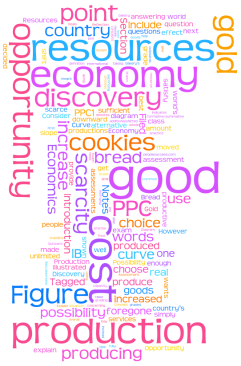Introduction
Markets
- Microeconomicsis the study of the behavior of individual markets.
- Macroeconomics is the study of how the economy as a whole works.
- Ceteris paribus is an assumption that all other variables are being held equal, when a single variable is being altered in an economic model.
- Positive economicsexamines matters of economics that can be proven to be right or wrong by looking at the facts.
- Normative economics examines matters of economics that are based upon opinion and so are incapable of being proven to be right or wrong.
- Scarcity exists because of the limited availability of economic resources relative to society’s unlimited demand for goods and services.
- Factors of production
- Land is the physical factor of production. It consists of natural resources, some of which are renewable and some of which are non-renewable.
- Labor is the human factor of production. It is the physical and mental contribution of the existing workforce to production.
- Capital is the factor of production that is made by humans and is used to produce goods and services. It occurs as a result of investment.
- Entrepreneurship is the factor of production involving the organization of the other factors of production and also involves risk-taking.
- Opportunity cost is the next best alternative foregone when an economic decision is made. example
- Free goodsare goods which are unlimited in supply and have no opportunity cost. A free good has an unlimited supply at market price zero.
- An economic good is a good or service that is relatively scarce and so has a price. An opportunity cost is involved when it is consumed.
- Utility is the satisfaction or pleasure that an individual derives from the consumption of a good or service.
- A production possibilities curve (PPC)shows the maximum combination of goods or services that can be produced by an economy in a give time period, if all the resources in the economy are being used fully and effectively.
- Actual outputis the production of goods and services in an economy achieved in a given time period.
- Potential output is the possible production that would be achieved in an economy if all available factors were employed.
- Actual growthoccurs when previously unemployed factors of production are brought into use.
- Potential growth occurs when the quantity and/or quality of factors of production within an economy is increased. example
- Economic growth is the growth of real output in an economy over time.
- Economic developmentis a broad concept involving improvement in standards of living, reduction in poverty, improved health and improved education. Increased freedom and economic choice may also be included.
- Sustainable development is economic development that meets the needs of the present without compromising the ability of future generations to meet their needs.
- Actual outputis the production of goods and services in an economy achieved in a given time period.
- A free market economyis an economy where the means of production are privately held by individuals and firms. Demand and supply determine what to produce, how to produce it and for whom to produce.
- A planned (command) economy is an economy where the means of production are owned by the state. The state determines what to produce, how to produce it and for whom to produce.
- A transition economy is an economy in the process of moving from a centrally planned economic system towards a more market-oriented economic system.

1 | Chloe Cho
June 17, 2011 at 6:08 pm
Hi unnie! your blog is so cooooool (:
i can feel the “smartness” haha anyways see you soon at Ivyline again…